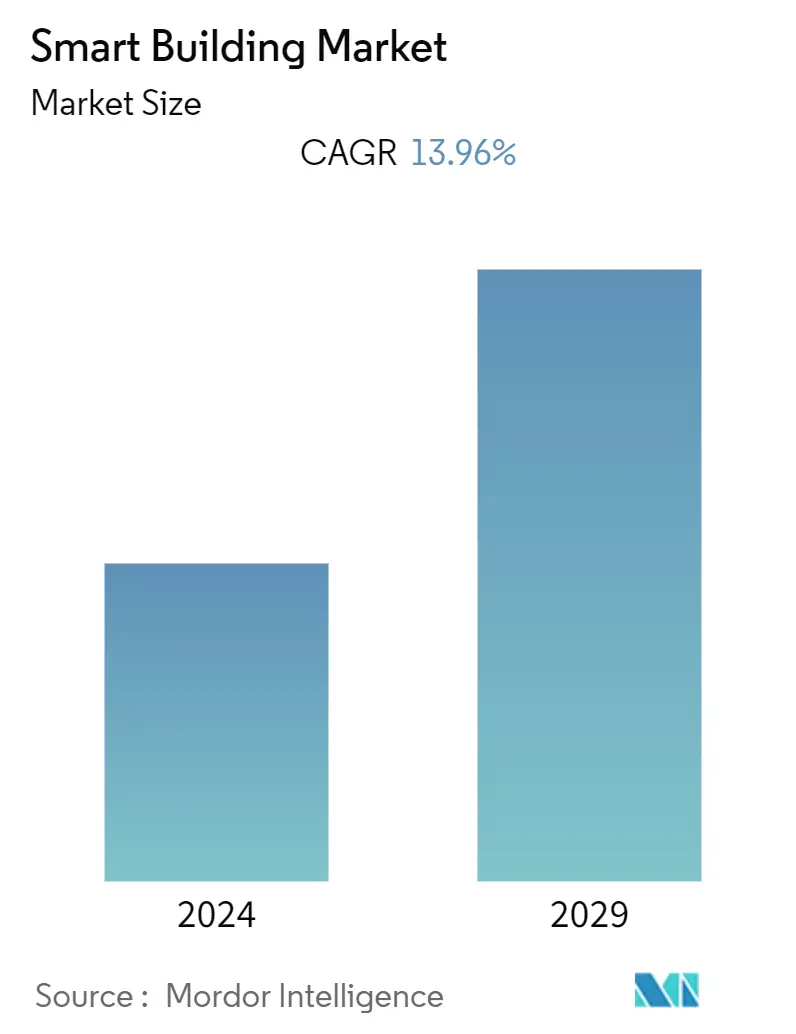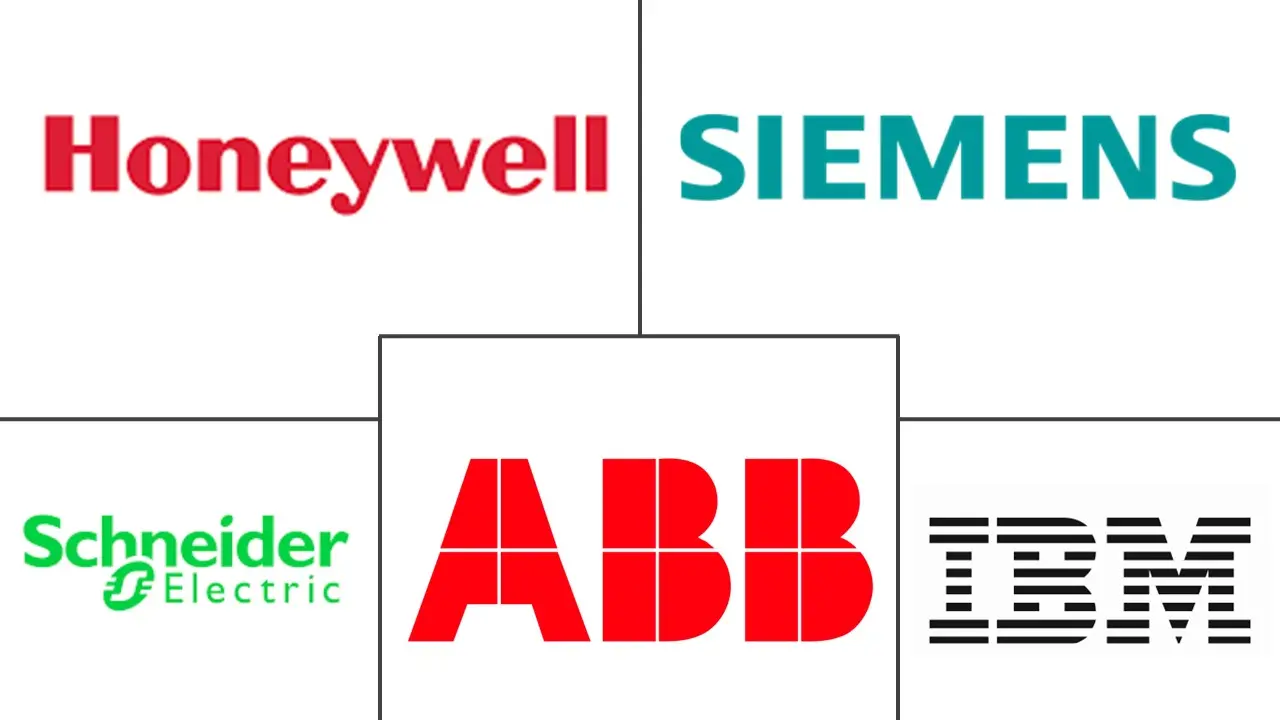Market Size of Smart Building Industry

| Study Period | 2019 - 2029 |
| Base Year For Estimation | 2023 |
| CAGR (2024 - 2029) | 13.96 % |
| Fastest Growing Market | Asia Pacific |
| Largest Market | North America |
| Market Concentration | Low |
Major Players
*Disclaimer: Major Players sorted in no particular order |
Smart Building Market Analysis
The Smart Building Market is expected to register a CAGR of 13.96% during the forecast period.
The growing smart cities sector, rising demand for energy-efficient buildings, and developments by market players are expected to drive the demand for smart buildings.
- The concept of smart cities created considerable opportunities in the energy, waste, and infrastructure sectors with the Internet of Things. Smart homes, a significant trend in smart city concepts, have several advantages. Several smart city projects and initiatives are currently underway. Many smart city projects and initiatives are being implemented worldwide, driving global investment through urbanization. The OECD estimates that global investment in smart city initiatives may reach approximately USD 1.8 trillion between 2010 and 2030 across all metropolitan infrastructure projects.
- Rising concerns about the surge in energy consumption globally are anticipated to fuel more advanced and energy-efficient technologies. However, stringent governance on energy consumption and green building initiatives also augment the demand for energy-efficient technology across buildings. This factor is expected to propel the implementation of smart building solutions globally.
- Therefore, businesses in any industry can adopt IoT devices, comprising smart thermostats and lighting systems, to minimize their electrical consumption and make buildings more sustainable. Since the adoption of IoT-enabled building management systems is increasing rapidly, it is creating awareness about space utilization industry standards and efficient energy usage.
- In addition to this, the demand is pushing energy services and technology companies to integrate their solutions and develop advanced mechanisms that can help consumers address challenges such as high energy bills and the removal of manual processes in doing so. The rapid pace of technological innovation presents exciting opportunities to enhance people's lives and promote sustainability. This furthermore provides lucrative opportunities for players to expand their position in the market with strategic developments.
- However, the market's growth is expected to be hampered by a shortage of competent professionals skilled in evaluating smart solution systems. Professionals in this field must be aware of design modifications and installations for future needs.
- The office reopening post-COVID-19 was projected to increase the smart technology demand for safe surroundings. Facility managers and tenant companies of commercial buildings needed to provide a secure office environment post-lockdown. Therefore, smart technology could manage regular cleaning and disinfection, proper ventilation of offices, smart access controls, temperature measurement devices, and optimization of spaces to maintain physical distancing. These factors are anticipated to increase the demand for smart building solutions.
Smart Building Industry Segmentation
Smart buildings automate processes that control lighting, infrastructure, heating, security systems, ventilation, and air conditioning. Smart buildings integrate technology into basic building infrastructure and other equipment, components, and structures to make buildings safer, more efficient, and sustainable and reduce costs. The smart building solutions investigated are part of the rising IoT and connected sensor ecosystem. Smart buildings use automation to optimize all or some of the processes inside the building: heating and cooling, ventilation, security, lighting, water usage, and more. Some benefits include reduced environmental impact, proactive maintenance of equipment, and reduced energy use and costs.
The Smart Building Market is segmented by Component (Solutions (Building Energy Management Systems, Infrastructure Management Systems, Intelligent Security Systems), Services), by Application (Residential, Commercial), and by Geography (North America, Europe, Asia-Pacific, Latin America, and Middle East & Africa). The market sizes and forecasts are provided in terms of value in USD for all the above segments.
| By Component | ||||||
| ||||||
| Services |
| By Application | |
| Residential | |
| Commercial |
| By Geography | |
| North America | |
| Europe | |
| Asia-Pacific | |
| Latin America | |
| Middle East and Africa |
Smart Building Market Size Summary
The smart building market is poised for significant growth, driven by the increasing integration of IoT technologies and the rising demand for energy-efficient and automated building solutions. The concept of smart cities, which encompasses smart homes, is creating substantial opportunities across various sectors, including energy, waste, and infrastructure. This trend is further fueled by global urbanization and the need for advanced technologies to address energy consumption concerns. Smart buildings offer numerous benefits, such as enhanced sustainability and reduced energy costs, by utilizing IoT devices like smart thermostats and lighting systems. The market is also witnessing a surge in demand for intelligent security systems, which leverage automation and data analytics to ensure the safety of occupants and assets. These systems are becoming increasingly important as buildings become more connected, necessitating robust security measures to prevent breaches.
North America stands out as a significant market for smart buildings, with the United States leading in the adoption of IoT-enabled devices and smart building solutions. The region's high internet penetration and consumer spending capabilities are driving the development and implementation of new technologies. Companies are focusing on innovative solutions to optimize energy consumption and enhance building automation. Strategic partnerships and product launches are prevalent, with major players like Honeywell, Siemens, ABB, Schneider Electric, and IBM actively expanding their offerings. The market's fragmentation is characterized by the presence of both global and national companies, all vying to provide customized and modern technologies to attract end users. As the market continues to evolve, it is expected to expand comprehensively, supported by ongoing technological advancements and strategic collaborations.
Smart Building Market Size - Table of Contents
-
1. MARKET INSIGHTS
-
1.1 Market Overview
-
1.2 Industry Value Chain Analysis
-
1.3 Industry Attractiveness - Porter's Five Forces Analysis
-
1.3.1 Threat of New Entrants
-
1.3.2 Bargaining Power of Buyers
-
1.3.3 Bargaining Power of Suppliers
-
1.3.4 Threat of Substitute Products
-
1.3.5 Intensity of Competitive Rivalry
-
-
1.4 Assessment of COVID-19's Impact on the Market
-
-
2. MARKET SEGMENTATION
-
2.1 By Component
-
2.1.1 Solutions
-
2.1.1.1 Building Energy Management Systems
-
2.1.1.2 Infrastructure Management Systems
-
2.1.1.3 Intelligent Security Systems
-
2.1.1.4 Other Solutions
-
-
2.1.2 Services
-
-
2.2 By Application
-
2.2.1 Residential
-
2.2.2 Commercial
-
-
2.3 By Geography
-
2.3.1 North America
-
2.3.2 Europe
-
2.3.3 Asia-Pacific
-
2.3.4 Latin America
-
2.3.5 Middle East and Africa
-
-
Smart Building Market Size FAQs
What is the current Smart Building Market size?
The Smart Building Market is projected to register a CAGR of 13.96% during the forecast period (2024-2029)
Who are the key players in Smart Building Market?
Honeywell International Inc., Siemens AG, Schneider Electric SE, IBM Corporation and ABB Ltd are the major companies operating in the Smart Building Market.

